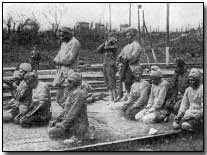Battles - The Battle of Neuve Chapelle, 1915
 Fought between 10-13 March 1915, the Battle of
Neuve Chapelle was originally intended to comprise part of a wider Allied
offensive in the Artois region.
Fought between 10-13 March 1915, the Battle of
Neuve Chapelle was originally intended to comprise part of a wider Allied
offensive in the Artois region.
However, delays in the arrival of relieving British troops for Ypres, owing to a redirection of effort towards Gallipoli, resulted in the attack on Neuve Chapelle being launched as a distinct action in its own right.
The decision to attack Neuve Chapelle, situated north of La Bassee and west of Lille in north-west France, was Sir John French's, Commander-in-Chief of the British Expeditionary Force (BEF). Whilst Neuve Chapelle was to form the initial target of the assault, French intended to capture the village at Aubers a mile to the east and to press the German defence of Lille. In achieving these aims French wished to reduce the small German salient near Neuve Chapelle.
Leading the attack was Douglas Haig's First Army, from which four divisions of 40,000 men were committed along a 3 km front at 7.30 am on 10 March. The infantry advance was preceded by a concentrated 35-minute artillery bombardment of 342 guns across a 2,000 yard line, directed in part by 85 reconnaissance aircraft from the Royal Flying Corps (RFC).
The historian Martin Gilbert has noted that more shells were discharged in the 35 minute bombardment than in the whole of the Boer War, a sobering reflection upon the transformation of warfare in the space of 15 years (1).
With the employment of carefully co-ordinated attacks of often hand-to-hand fighting by British and Indian infantry, initial progress was rapid, quickly breaking through a section of the German line secured by only a single division of Crown Prince Rupprecht's Sixth Army at Neuve Chapelle village. It had taken just four hours to secure the village.
 Having
achieved a real gain in the capture of the village, supply and communication
problems began to plague Haig's troops.
Having
achieved a real gain in the capture of the village, supply and communication
problems began to plague Haig's troops.
Rupprecht dispatched reserves to Neuve Chapelle, launching a counter-attack on 12 March. The British nevertheless managed to hold their gains, some 2 km of ground originally lost in October 1914, but further progress towards Aubers - which had escaped artillery bombardment, and where the front line wire was thus undamaged - proved impossible; of some 1,000 troops who attacked Aubers none survived. The attack was consequently halted on 13 March.
Allied casualties during the battle were 11,200 (7,000 British, 4,200 Indian); losses among the German Sixth Army were roughly similar, although 1,200 German troops were captured by the British.
French in part blamed a shortage of artillery shells for the lack of success beyond the initial advance, intending to stockpile greater quantities for use in future preliminary bombardments. However, in extending the duration of such bombardments the vital element of surprise vital to such attacks was lost, giving the Germans valuable additional time in which to rush reserves to the site of the bombardment.
Click here to read a contemporary report of the action at Neuve Chapelle. Click here to read an equivalent German magazine report.
Photographs courtesy of Photos of the Great War website
The term "Grand Slam" was British slang for a pending battle or attack.
- Did you know?
